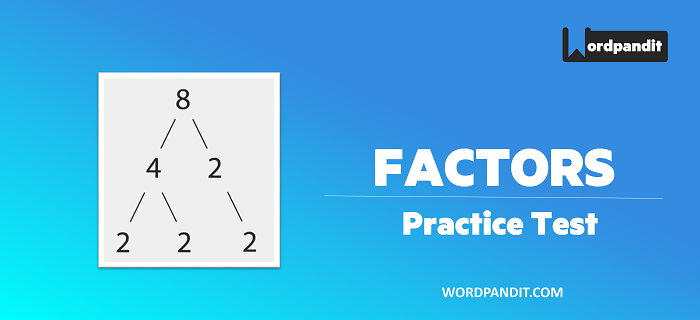- This is an assessment test.
- To draw maximum benefit, study the concepts for the topic concerned.
- Kindly take the tests in this series with a pre-defined schedule.
Number System: Basics of Factors Test-2
Congratulations - you have completed Number System: Basics of Factors Test-2.You scored %%SCORE%% out of %%TOTAL%%.You correct answer percentage: %%PERCENTAGE%% .Your performance has been rated as %%RATING%%
Your answers are highlighted below.
Question 1 |
Find the number of factors 180
32 | |
20 | |
18 | |
22 |
Question 1 Explanation:
The number of factors are given by the formula (p+1)(q+1)(r+1), where p,q,r are the powers of the prime factors of the number.
Step 1: prime factorisation
i.eapbqcr form
i.e 223251 Step 2: (2+1)(2+1)(1+1) = 18
So the option c is the right answer
Step 1: prime factorisation
i.eapbqcr form
i.e 223251 Step 2: (2+1)(2+1)(1+1) = 18
So the option c is the right answer
Question 2 |
How many factors of 220 are three digit numbers?
2 | |
4 | |
1 | |
3 |
Question 2 Explanation:
In the problem we are asked to find the factors having three digits, so insteadof the long procedure, we adopt a short-cut.
Simply divide 220 by 2, i.e220/2 =110 110/2=55
now 55 is two digit number, hence we can’t include it in the answer.
All subsequent factors would be less than 110.
So the total number of factors which are three digit numbers are 2 i.e. 220,110.
So option 1 is the right answer
Simply divide 220 by 2, i.e220/2 =110 110/2=55
now 55 is two digit number, hence we can’t include it in the answer.
All subsequent factors would be less than 110.
So the total number of factors which are three digit numbers are 2 i.e. 220,110.
So option 1 is the right answer
Question 3 |
In how many ways can 75 be written as the product of its co-prime numbers?
3 | |
5 | |
6 | |
1 |
Question 3 Explanation:
\[\begin{align}
& Product\text{ }of\text{ }co-prime\text{ }numbers\text{ }can\text{ }be\text{ }identified\text{ }by\text{ }{{2}^{k}}-1\text{ } \\
& where\text{ }k\text{ }is\text{ }the\text{ }number\text{ }of\text{ }prime\text{ }numbers\text{ } \\
& used\text{ }in\text{ }the\text{ }prime\text{ }factorisation. \\
\end{align}\]
\[Therefore:\] \[Step\text{ }1:\text{ }Prime\text{ }factorisation\text{ }75\text{ }=\text{ }{{5}^{2}}{{3}^{1}}\] \[Step\,\,2\text{ }:\text{ }There\text{ }are\text{ }two\text{ }prime\text{ }numbers\text{ }are\text{ }used\text{ }\] \[so\text{ }{{2}^{2}}-1=\text{ }3\text{ }so\text{ }the\text{ }right\text{ }answer\text{ }is\text{ }option\text{ }1.\] \[The\text{ }2\text{ }products\text{ }of\text{ }co-prime\text{ }numbers\text{ }in\text{ }this\text{ }case\text{ }\] \[are\text{ }1\times 75\text{ }and\text{ }3\times 25.\]
\[Therefore:\] \[Step\text{ }1:\text{ }Prime\text{ }factorisation\text{ }75\text{ }=\text{ }{{5}^{2}}{{3}^{1}}\] \[Step\,\,2\text{ }:\text{ }There\text{ }are\text{ }two\text{ }prime\text{ }numbers\text{ }are\text{ }used\text{ }\] \[so\text{ }{{2}^{2}}-1=\text{ }3\text{ }so\text{ }the\text{ }right\text{ }answer\text{ }is\text{ }option\text{ }1.\] \[The\text{ }2\text{ }products\text{ }of\text{ }co-prime\text{ }numbers\text{ }in\text{ }this\text{ }case\text{ }\] \[are\text{ }1\times 75\text{ }and\text{ }3\times 25.\]
Question 4 |
The product of divisors of 120 will be
(233151)16 | |
(233151)8 | |
(233151)20 | |
(233151)4 |
Question 4 Explanation:
Product of divisors means the product of all the factors of number ,
the product of all the factors may be calculated as NX/2
where N is the number and X is number of factors ,
so the product of all the factors or product of divisors is given by option B,
that is (233151)8
the product of all the factors may be calculated as NX/2
where N is the number and X is number of factors ,
so the product of all the factors or product of divisors is given by option B,
that is (233151)8
Question 5 |
In how many number of ways 36 can be expressed as the product of two distinct factors?
10 | |
5 | |
8 | |
4 |
Question 5 Explanation:
Step 1: 36 = 2232
Step 2: Number of factors (2+1)(2+1)=9
Step 3: Product of two distinct factors= (Number of factors + 1)/2 ; if the number is a perfect square
Number of ways to express a number as a product of two factors, = (Number of factors)/2 ;
if the number is not a perfect square Illustration of the case above:
Take the number 6 Number of factors = 4= 1,2,3,6
can be written as: 1*6 , 2*3
We can’t repeat 6*1 and 3*2 as they are already taken. Hence only 2 ways.
Another example: take 9.
Number of factors = 3 =1,3,9
Can be written as 1*9 only. Hence only 1 way.
Hence number of ways = (9-1)/2=4 so the right option is d
These four pairs will be: (2,18), (1, 36), (4, 9) and (3, 12).
Remember in the problem we are asked the distinct factors so we are not using 6x6, in which both the numbers are same.
Step 2: Number of factors (2+1)(2+1)=9
Step 3: Product of two distinct factors= (Number of factors + 1)/2 ; if the number is a perfect square
Number of ways to express a number as a product of two factors, = (Number of factors)/2 ;
if the number is not a perfect square Illustration of the case above:
Take the number 6 Number of factors = 4= 1,2,3,6
can be written as: 1*6 , 2*3
We can’t repeat 6*1 and 3*2 as they are already taken. Hence only 2 ways.
Another example: take 9.
Number of factors = 3 =1,3,9
Can be written as 1*9 only. Hence only 1 way.
Hence number of ways = (9-1)/2=4 so the right option is d
These four pairs will be: (2,18), (1, 36), (4, 9) and (3, 12).
Remember in the problem we are asked the distinct factors so we are not using 6x6, in which both the numbers are same.
Once you are finished, click the button below. Any items you have not completed will be marked incorrect.
There are 5 questions to complete.
List |











